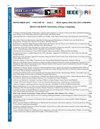基于输出调节理论和高增益观测器的机械臂离散未建模参考信号跟踪
IF 1.3
4区 工程技术
Q3 COMPUTER SCIENCE, INFORMATION SYSTEMS
引用次数: 0
摘要
在控制领域,输出调节理论保证了对已知动态外生系统(exosystem)产生的参考信号的跟踪。然而,在一些应用中,系外系统可能是未知的。在此背景下,本文提出了一种基于弗朗西斯输出调节理论的控制器,其中使用高增益观测器(HGO)来估计未建模参考信号的状态。该观测器在结构上作为外系统集成到弗朗西斯输出调节方程的离散形式中。该方法假设将给定轨迹从工作空间变换到机器人关节空间,得到离散时间未建模的参考信号。因此,在笛卡尔空间中运动的精度取决于每个关节的跟踪误差。以一个二自由度机器人为例,以其动力学模型作为构造控制器的基础。最后,利用Simulink-Simscape开发的多体模型进行了仿真,证明了所提出的控制器满足稳定性和渐近调节准则。本文章由计算机程序翻译,如有差异,请以英文原文为准。
Tracking of discrete-time unmodeled reference signals in robotic manipulators using output regulation theory and high-gain observers
In the field of control, output regulation theory ensures the tracking of reference signals generated by a known dynamic exogenous system, referred to as the exosystem. However, there are applications where the exosystem may be unknown. In this context, the present paper proposes a controller based on Francis output regulation theory, where a high-gain observer (HGO) is used to estimate the states of the unmodeled reference signals. This observer is structurally integrated into the discrete form of Francis output regulation equations as the exosystem. The proposed approach assumes that discrete-time unmodeled reference signals are obtained by transforming a given trajectory from the workspace into joint space of a robotic manipulator. Consequently, the accuracy of motion in Cartesian space depends on the tracking error in each joint. As a case study, a two-degree-of-freedom robot is presented, and its dynamic model is used as the basis for constructing the controller. Finally, simulations are performed using a multibody model developed in Simulink-Simscape to demonstrate that the proposed controller satisfies the stability and asymptotic regulation criteria.
求助全文
通过发布文献求助,成功后即可免费获取论文全文。
去求助
来源期刊

IEEE Latin America Transactions
COMPUTER SCIENCE, INFORMATION SYSTEMS-ENGINEERING, ELECTRICAL & ELECTRONIC
CiteScore
3.50
自引率
7.70%
发文量
192
审稿时长
3-8 weeks
期刊介绍:
IEEE Latin America Transactions (IEEE LATAM) is an interdisciplinary journal focused on the dissemination of original and quality research papers / review articles in Spanish and Portuguese of emerging topics in three main areas: Computing, Electric Energy and Electronics. Some of the sub-areas of the journal are, but not limited to: Automatic control, communications, instrumentation, artificial intelligence, power and industrial electronics, fault diagnosis and detection, transportation electrification, internet of things, electrical machines, circuits and systems, biomedicine and biomedical / haptic applications, secure communications, robotics, sensors and actuators, computer networks, smart grids, among others.
 求助内容:
求助内容: 应助结果提醒方式:
应助结果提醒方式:


